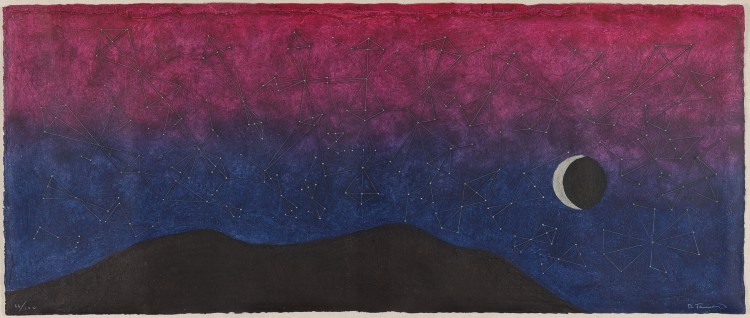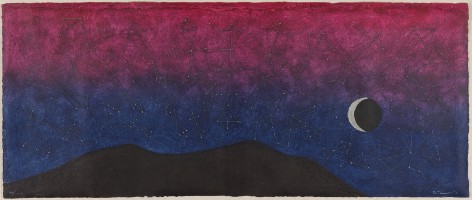
What you see: Galaxia, a 1977 print by Rufino Tamayo. Swann Auction Galleries estimates it at $10,000 to $15,000.
The expert: Todd Weyman, vice president at Swann and director of prints and drawings.
Who was Rufino Tamayo? He was a famous Mexican artist who started as a painter and a printmaker in the late 1920s. He was also well-traveled and worked in various artistic centers around the world. He wasn’t the “revolutionary” artist that [fellow Mexican artists] Diego Rivera and David Siqueiros were. His work has a much different tenor.
What role did printmaking play in Rufino Tamayo’s career? It was instrumental to his career and it propelled him to worldwide renown, but he was known for his paintings and murals.
How often do night scenes appear in Rufino Tamayo’s work? Is is a theme he returned to often, or is Galaxia a rarity? He produced night scenes throughout his career, in his paintings as well as his prints. Galaxia is by far the most ambitious and best-known. It stands apart for its size, its ambition, and its graphic quality.
Do we know what moved Rufino Tamayo to create Galaxia? He was drawing from his Zapotec heritage. The Mesoamericans based their calendar on constellations. The knowledge was passed down through the generations. Tamayo was tapping into that. He might have chosen night images to bring the ancient Mesoamerican traditions to life.
Does the Rufino Tamayo Galaxia print depict a real place, or is it imagined? It’s almost certainly of his own invention.
Do the constellations in Galaxia correspond to known constellations? They don’t appear to be. Tamayo was drawing on the graphic quality – the dots and lines – to create a rhythmic repetition in the piece. They’re more decorative than realistic.
The Galaxia print’s medium is called “color Mixografía.” I haven’t encountered that medium before. What is Mixografía? It’s a separate printing technique developed by Tamayo in conjunction with the Taller de Gráfica Mexicana printmaking workshop in Mexico City. [The studio later changed its name to Mixografía and relocated to Los Angeles.]
Could you talk about how Rufino Tamayo uses color in Galaxia? He sure gets a lot of expression out of that purple. The color is magnificent. Above all, Tamayo is a great colorist. In particular, the Mixografía prints were made on very absorbent handmade paper with a cotton-like texture. It allowed the colors to bleed and blend in a manner not unlike watercolors. The tones of the vast moonlit sky give the image a wonderful ethereal quality.
How thick is the paper? In some cases, the handmade Mixografía papers are a quarter-inch or more thick. It’s a very hefty, ultra-handmade paper. It feels more like pressed cotton pulp than a fine, finished paper.
In Tamayo’s obituary in the New York Times, poet Octavio Paz said: “If I could express with a single word what it is that distinguishes Tamayo from other painters of our age, I would say, without a moment’s hesitation: sun. For the sun is in all his pictures, whether we see it or not; night itself is for Tamayo simply the sun carbonized.” Do we see Paz’s observation reflected in Galaxia? I would say so. Tamayo portrayed powerful natural phenomena as mystical forces. He didn’t just incorporate elements in his work as background–he made them the subject of his work. The sun is a sheer, all-encompassing power that makes humans seem insignificant in the face of nature.
How does the moon in Galaxia match the power of the sun in Tamayo’s work? It imparts the vastness of Tamayo’s imagery in its size and scale, and its focus on the night sky, the constellations, the moon, and the shadow of the mountain. There’s no human presence, just a vast night desert sky.
When did Rufino Tamayo start working with the Taller de Gráfica Mexicana print workshop? They started working together in 1973 when Tamayo wanted to incorporate texture and dimensionality in his prints in the same way as in his fresco work. Taller de Gráfica Mexicana was a second-generation print workshop operated by Luis Remba and his wife, Lea.
How thick is the layer of ink on the Mixografía paper? Is it similar to impasto? It’s not impasto in the sense of [that seen on] a painting, but it has impasto-like qualities.
The Rufino Tamayo Galaxia print is large and long–20 inches by 47¼ inches. First of all – is it printed on one sheet or more than one sheet that’s been joined to make a whole? Amazingly, it’s one sheet.
This is a big, weird size for a print. Did Galaxia pose any extra challenges to make? Tamayo had to specifically produce handmade paper for his prints, and he had to customize it for each of his editions, including Galaxia.
Making paper by hand … that’s not trivial. Not at all, but it’s something the printmakers would have been accustomed to, despite the challenges.
Did the Rembas have to build a special press to realize Galaxia? They had to build a special press, but they built it in 1973, in advance of this [the creation of the Mixografía print medium].
Is Galaxia the largest print that Rufino Tamayo made? No, he did larger. [Laughs]. In May 2019, we actually had one that was almost 60 inches by 95 inches. Its maquette utilized the largest lithographic stone ever produced. It still survives at the Mixografía workshop. Imagine working with that in the studio.
The lot notes describe the Rufino Tamayo Galaxia print as a “large, scarce print”, but I see this is number 66 of 100. I don’t necessarily think of a limited edition print run of 100 as translating to scarcity. What makes this print scarce? Given the size of Galaxia, its delicateness, and the care that goes into preserving it, it’s scarce. There have been only four at auction, including this one, in the last 30 years.
Now that you mention it, how do collectors store a Rufino Tamayo Galaxia print without damaging the ink? Most that I see are kept in shadow box frames. The paper has a textured quality, and the ink is not completely flat. It needs room, and also protection. You can’t pile it with other things in a flat file.
What’s the world auction record for a Rufino Tamayo Galaxia print? Interestingly, the last impression to go to auction was at Swann in 2018. It achieved $11,875.
How does the 2018 Galaxia compare to the one you have in the upcoming sale? Do you think it will beat the record set two years ago? I think the odds of beating it are fairly strong. The market for Tamayo has gotten stronger. The 2018 impression and this one are fairly equivalent. If anything, there’s one fewer on the market. It’s a little more scarce. It might be a little more sought-after.
What is the Rufino Tamayo Galaxia print like in person? I’m guessing it, more than most, is tough to translate to pixels on a screen. It’s difficult. The paper is wonderfully textured, and the colors are so vivid and deep. When you’re in front of it, it transports you. It’s not a characterless inked sheet of paper. There’s a mood about it, something about the colors and the view.
It’s easy to imagine crickets chirping or frogs croaking as you look at it. Galaxia is large. As you stare at it, nothing else is in your field of vision. Your isolation under the night sky is imaginable.
Why will this Rufino Tamayo Galaxia print stick in your memory? I think it’s so evocative of his work. You can see in it the artist’s hand and his creativity. And it is transporting. There’s something universal about the beauty of a night sky like this. Everyone gets to see one at some point.
How to bid: Rufino Tamayo’s Galaxia print is lot 402 in the Old Masters Through Modern Prints sale at Swann Auction Galleries on May 21, 2020.
___
By SHEILA GIBSON STOODLEY
Sheila Gibson Stoodley is a journalist and the author of The Hot Bid, which features intriguing lots coming up at auction.


